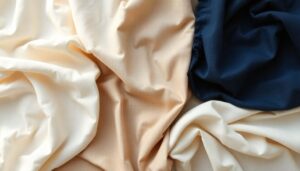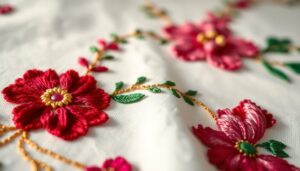Natural dyes have a rich history, woven into textiles, fashion, food, and cosmetics. They're celebrated for their eco-friendliness and ability to improve visual appeal. From lively fabrics to colorful culinary creations, these dyes are derived from plants, minerals, and insects, reflecting cultural heritage. They not just promote sustainability but likewise offer health benefits, reducing risks associated with synthetic dyes. For those interested in learning more about the techniques and future trends in natural dyeing, there's much to explore.
Article Highlights
- Natural dyes enhance textiles, fashion, and home decor with rich, organic hues while promoting sustainability and cultural heritage.
- They provide a chemical-free alternative for culinary applications, improving the visual appeal of dishes without harmful additives.
- Natural dyes are safer for skin and hair, reducing the risk of allergic reactions compared to synthetic options.
- Their use supports local agriculture and economies, contributing to biodiversity and healthier ecosystems.
- Traditional dyeing techniques help preserve cultural heritage, strengthen community ties, and promote sustainable craftsmanship.
Historical Significance of Natural Dyes

Although modern synthetic dyes dominate today's textile industry, natural dyes have a rich history that spans thousands of years. Ancient civilizations, from the Egyptians to the Mayans, relied heavily on these dyes, using plants, minerals, and insects to create lively colors. The cultural significance of natural dyes can't be overstated; they were often tied to social status, rituals, and traditions. For instance, indigo was revered in many cultures for its deep blue hue, often symbolizing wealth and prestige. Natural dyes additionally played a role in trade, with regions specializing in specific colors, nurturing connections between communities. As a result, these dyes not only colored textiles but also woven stories of heritage and identity that resonate even today.
Textiles and Fashion: A Colorful Revival
The resurgence of natural dyes in textiles and fashion reflects a growing demand for eco-friendly choices. Designers are increasingly turning to traditional dyeing techniques, which not merely improve sustainability but additionally celebrate cultural heritage. This colorful revival is paving the way for innovative textile solutions that prioritize both style and environmental consciousness.
Eco-Friendly Fashion Choices
As consumers become more conscious of their environmental impact, eco-friendly fashion choices are gaining popularity in the textile industry. Brands are increasingly focusing on sustainable materials and ethical production processes, allowing shoppers to make choices that align with their values. This movement not only promotes a healthier planet but likewise supports fair labor practices.
- Protecting our Earth for future generations
- Supporting artisans and local communities
- Embracing unique, handcrafted designs
- Reducing waste and pollution
- Reviving traditional craftsmanship
Traditional Dyeing Techniques
Incorporating eco-friendly fashion choices often leads to a renewed interest in traditional dyeing techniques, which celebrate both artistry and sustainability. These methods frequently utilize indigenous techniques passed down through generations, showcasing regional variations that highlight local flora and culture.
| Technique | Description |
|---|---|
| Ikat | A resist-dyeing technique where threads are dyed before weaving. |
| Shibori | A Japanese method involving folding, twisting, or bunching fabric to create patterns. |
| Batik | An Indonesian technique using wax to resist dye on fabric, resulting in intricate designs. |
Such practices not only yield stunning textiles but additionally strengthen connections to heritage and environmental responsibility, making them fundamental in today's fashion environment.
Sustainable Textile Innovations
Even though traditional dyeing techniques celebrate heritage, sustainable textile innovations are reshaping the fashion environment by blending modern technology with eco-conscious practices. Designers are increasingly utilizing sustainable materials and innovative practices, ensuring that the future of fashion aligns with environmental responsibility. This shift not only preserves cultural identities but additionally promotes a healthier planet.
- Revitalizing communities through eco-friendly job creation
- Reducing water waste and pollution in textile production
- Reviving ancient techniques with a modern twist
- Encouraging consumer awareness about textile sourcing
- Inspiring a new generation of environmentally-conscious designers
Natural Dyes in Home Decor
Natural dyes offer a unique way to infuse warmth and character into home decor, enhancing spaces with their rich, organic hues. These dyes, derived from plants, insects, and minerals, create stunning natural dye textiles that can transform any room. Homeowners can incorporate colorful home accents through items like cushions, curtains, and table linens, bringing vibrancy and a touch of nature indoors. Unlike synthetic dyes, natural dyes promote sustainability and feature a softer, more inviting palette. As these textiles age, they often develop a timeless patina, adding to their charm. By choosing natural dye textiles, individuals not only enhance their decor but additionally contribute to eco-friendly practices, creating spaces that reflect both beauty and environmental consciousness.
Applications in Food Coloring

The lively hues of natural dyes extend beyond home decor, finding their way into the culinary world as well. Chefs and home cooks alike are discovering the joy of using natural dyes to improve their dishes, creating visually stunning meals. With various natural dye recipes, they can explore color extraction methods from fruits, vegetables, and even spices.
- Brighten up baked goods with beet juice
- Add a colorful touch to pasta using spinach
- Raise beverages with hibiscus petals
- Create eye-catching rice with turmeric
- Transform frosting with natural berry extracts
These techniques not only beautify food but promote healthier eating habits. Embracing natural dyes in cooking encourages creativity, transforming everyday meals into delightful culinary experiences.
Cosmetic Uses of Natural Dyes
Natural dyes offer an appealing alternative for hair coloring, providing lively hues without harsh chemicals. Many individuals are likewise exploring skin staining techniques, which use these dyes for temporary body art and cosmetics. This trend highlights a growing interest in safer, eco-friendly beauty solutions.
Hair Coloring Alternatives
For those seeking a more organic approach to hair coloring, turning to natural dyes offers a lively and healthier alternative. Utilizing herbal hair solutions not only improves one's appearance but additionally nurtures the scalp and strands. These plant pigments, derived from nature, provide vivid hues without the harsh chemicals found in conventional dyes, making them a great choice for the environmentally conscious.
- Embrace vivid, rich colors without harmful additives.
- Experience gentle care for your hair and scalp.
- Discover a connection to nature with every application.
- Enjoy a personalized dye experience customized to your preferences.
- Feel confident knowing you're making a sustainable choice.
Natural dyes can transform hair during the promotion of overall hair health, proving that beauty doesn't have to come at a cost.
Skin Staining Techniques
Though many seek lively hair colors through natural dyes, these plant-based pigments also offer exciting possibilities for skin staining techniques. Natural dyes can be applied to the skin for a range of cosmetic purposes, from temporary tattoos to body art. The process involves careful dye application, ensuring the skin is clean and free from oils for better absorption. Common natural dyes used for skin staining include henna, indigo, and beetroot, each providing unique hues and effects. Users should always conduct a patch test to avoid allergic reactions. With their bright colors and skin-friendly properties, natural dyes have become a popular choice for those looking to improve their beauty routines in a safe, eco-friendly way.
Benefits for Eco-Friendly Crafting

Crafting with eco-friendly dyes not merely encourages creativity but similarly promotes sustainability in a world increasingly focused on environmental impact. Using natural dyes made from plant-based sources, artisans can create lively works during minimizing their carbon footprint. By participating in community workshops, crafters can share knowledge and resources, nurturing a sense of belonging and environmental responsibility.
- It's a chance to connect with nature.
- Crafters inspire others to make mindful choices.
- Projects become unique expressions of personal values.
- The community grows stronger through shared eco-friendly practices.
- It supports local economies dedicated to sustainability.
Embracing eco-friendly materials in crafting not only yields beautiful results but additionally strengthens the commitment to a healthier planet.
Environmental Impact and Sustainability
Natural dyes not just improve the artistic process but in addition play a significant role in promoting environmental sustainability. These dyes often come from renewable resources, such as plants, insects, and minerals, which can be cultivated without depleting natural ecosystems. By utilizing these materials, artisans contribute to biodiversity benefits, nurturing a healthier environment. Natural dyeing practices likewise minimize the reliance on synthetic chemicals, which can harm ecosystems and human health. Moreover, the cultivation of dye plants supports local agriculture and economies, encouraging a more sustainable approach to crafting. As consumers become more aware of their choices, the shift in the direction of natural dyes signifies a commitment to protecting the planet as well as celebrating traditional craftsmanship. Overall, natural dyes offer a valuable alternative in the pursuit of sustainability.
Health Advantages of Natural Dyes
As consumers increasingly seek healthier alternatives, the use of natural dyes presents several health advantages. Unlike synthetic dyes, natural options often boast better skin safety, reducing the risk of allergic reactions and irritations. These dyes, derived from plants and minerals, provide significant health benefits, making them appealing for those concerned about chemical exposure.
- Supports skin health
- Reduces allergy risks
- Environmentally friendly
- Non-toxic ingredients
- Promotes overall well-being
Techniques for Dyeing With Natural Sources
When exploring techniques for dyeing with natural sources, one cannot overlook the variety of plant-based dye sources available. The process typically involves several key steps, from selecting the right materials to preparing the fabric for ideal color absorption. Comprehending these methods can greatly improve the quality and richness of the final dyed product.
Plant-Based Dye Sources
Even though many people may associate dyeing with synthetic chemicals, plant-based dye sources offer a rich and colorful alternative. These natural dyes come from various plants and can produce stunning hues through simple dye extraction processes. The use of plant-based pigments not merely reflects a commitment to sustainability but additionally connects individuals to nature in a meaningful way.
- Bright colors that tell a story
- A deeper appreciation for the environment
- A sense of nostalgia and tradition
- The joy of creating something unique
- Healthier choices for you and the planet
Dyeing Process Steps
Dyeing with natural sources involves several clear steps that guarantee lively and lasting colors. First, one needs to prepare the fabric by washing it to remove any residues. Next, a mordant is applied; this helps fix the dye to the fabric, addressing potential colorfastness issues. Different dyeing techniques, like immersion or tie-dye, can then be employed, depending on the desired effect. Once dyed, the fabric should be rinsed thoroughly to remove excess dye. Finally, allowing the fabric to dry in a shaded area helps preserve the colors. By following these steps, artisans can achieve rich, colorful hues that stand the test of time, as they minimize potential concerns about fading and color retention.
Future Trends in Natural Dyeing Practices
As the world increasingly embraces sustainability, the future of natural dyeing practices looks promising and innovative. With a growing interest in eco-friendly solutions, the use of natural dyes is broadening through innovative applications and community workshops. These initiatives nurture creativity and knowledge-sharing, helping people reconnect with traditional methods.
- Revitalization of local flora for dye sources
- Increased accessibility to eco-conscious products
- Strengthening of community ties through shared learning
- Preservation of cultural heritage and craftsmanship
- Positive environmental impact through reduced chemical usage
These trends not merely highlight the versatility of natural dyes but additionally encourage a collective movement toward more sustainable practices. As awareness grows, natural dyeing could become a staple in both fashion and home decor.
Frequently Asked Questions
Are Natural Dyes Safe for Children's Clothing?
When considering if natural dyes are safe for children's clothing, one must look at safety standards and colorfast testing. Many manufacturers guarantee their products meet regulatory guidelines, which can provide reassurance. If a dye has undergone thorough colorfast testing, it's less likely to fade or transfer onto skin. Parents should always check for certifications and ask about the dyeing process to confirm their children's clothing is both lively and safe to wear.
Can Natural Dyes Be Used on Synthetic Fabrics?
In the realm of textiles, the fit between dyes and fabrics often resembles a dance. Although natural dyes aren't always compatible with synthetic fabrics because of their chemical makeup, there are techniques that may bridge the gap. By employing specific natural dye techniques, one can sometimes achieve successful results on synthetic materials. Nevertheless, it's essential to understand that the permanence and vibrancy of the colors might vary greatly compared to natural fibers.
How Long Do Natural Dyes Typically Last?
When considering how long natural dyes typically last, it's important to understand that dye longevity factors play an essential role. Factors like fabric type, exposure to sunlight, and washing methods can affect the color's durability. Colorfastness testing is often conducted to determine how well a dye withstands these elements. Typically, with proper care, natural dyes can maintain their vibrancy for several years, but their longevity can vary widely based on these conditions.
Are There Any Allergens in Natural Dyes?
When one envisions a lively garden, it's easy to overlook potential allergens concealed among the petals. In natural dyes, allergen sources can arise from plants like madder or indigo, which some individuals might react to because of dye sensitivity. As many people enjoy these dyes without issues, it's essential for those with sensitivities to conduct patch tests first. This precaution helps guarantee their colorful creations don't come with unexpected skin reactions.
How Do I Store Dyed Items to Preserve Color?
To preserve color in dyed items, one should store them in a cool, dark place, away from direct sunlight. This helps prevent dye fading. It's important to keep the items in breathable fabrics, like cotton, to avoid moisture buildup. Furthermore, using acid-free tissue paper between layers can protect against abrasion. Regularly checking the stored items guarantees they remain bright, maintaining their beautiful colors over time.













